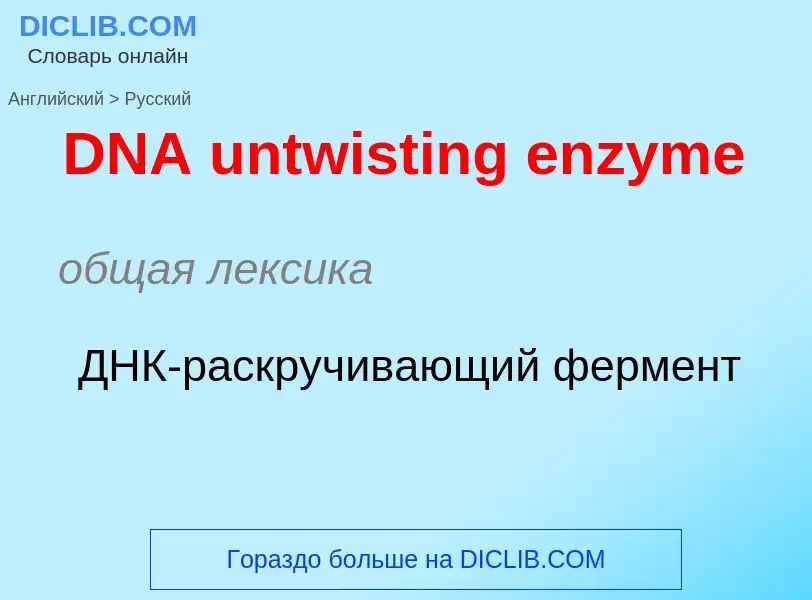Μετάφραση και ανάλυση λέξεων από την τεχνητή νοημοσύνη ChatGPT
Σε αυτήν τη σελίδα μπορείτε να λάβετε μια λεπτομερή ανάλυση μιας λέξης ή μιας φράσης, η οποία δημιουργήθηκε χρησιμοποιώντας το ChatGPT, την καλύτερη τεχνολογία τεχνητής νοημοσύνης μέχρι σήμερα:
- πώς χρησιμοποιείται η λέξη
- συχνότητα χρήσης
- χρησιμοποιείται πιο συχνά στον προφορικό ή γραπτό λόγο
- επιλογές μετάφρασης λέξεων
- παραδείγματα χρήσης (πολλές φράσεις με μετάφραση)
- ετυμολογία
DNA untwisting enzyme - translation to ρωσικά
общая лексика
ДНК-раскручивающий фермент
общая лексика
раскручивающий (ДНК) фермент
синоним
[enzai'mætik]
общая лексика
ферментативный
медицина
ферментный
энзиматический
прилагательное
общая лексика
ферментативный
энзимный
Ορισμός
Βικιπαίδεια
DNA topoisomerases (or topoisomerases) are enzymes that catalyze changes in the topological state of DNA, interconverting relaxed and supercoiled forms, linked (catenated) and unlinked species, and knotted and unknotted DNA. Topological issues in DNA arise due to the intertwined nature of its double-helical structure, which, for example, can lead to overwinding of the DNA duplex during DNA replication and transcription. If left unchanged, this torsion would eventually stop the DNA or RNA polymerases involved in these processes from continuing along the DNA helix. A second topological challenge results from the linking or tangling of DNA during replication. Left unresolved, links between replicated DNA will impede cell division. The DNA topoisomerases prevent and correct these types of topological problems. They do this by binding to DNA and cutting the sugar-phosphate backbone of either one (type I topoisomerases) or both (type II topoisomerases) of the DNA strands. This transient break allows the DNA to be untangled or unwound, and, at the end of these processes, the DNA backbone is resealed. Since the overall chemical composition and connectivity of the DNA do not change, the DNA substrate and product are chemical isomers, differing only in their topology.



!['''Paused RNA polymerase and limited, short-term topo IIβ-induced DNA double-strand break.''' The 5' ends of DNA are covalently joined to tyrosine within the topo IIβ dimer-PARP-1 complex. The [[non-homologous end joining]] DNA repair pathway components DNA-PKcs, Ku70/Ku80 and DNA ligase are also closely associated with the topo IIβ dimer-PARP-1 complex. '''Paused RNA polymerase and limited, short-term topo IIβ-induced DNA double-strand break.''' The 5' ends of DNA are covalently joined to tyrosine within the topo IIβ dimer-PARP-1 complex. The [[non-homologous end joining]] DNA repair pathway components DNA-PKcs, Ku70/Ku80 and DNA ligase are also closely associated with the topo IIβ dimer-PARP-1 complex.](https://commons.wikimedia.org/wiki/Special:FilePath/DNA DSB TOP2B PARP-1 complex with NHEJ enzymes.jpg?width=200)





![recessive]] fashion because the enzymes from the unaffected genes are generally sufficient to prevent symptoms in carriers. recessive]] fashion because the enzymes from the unaffected genes are generally sufficient to prevent symptoms in carriers.](https://commons.wikimedia.org/wiki/Special:FilePath/Autosomal recessive inheritance for affected enzyme.png?width=200)

